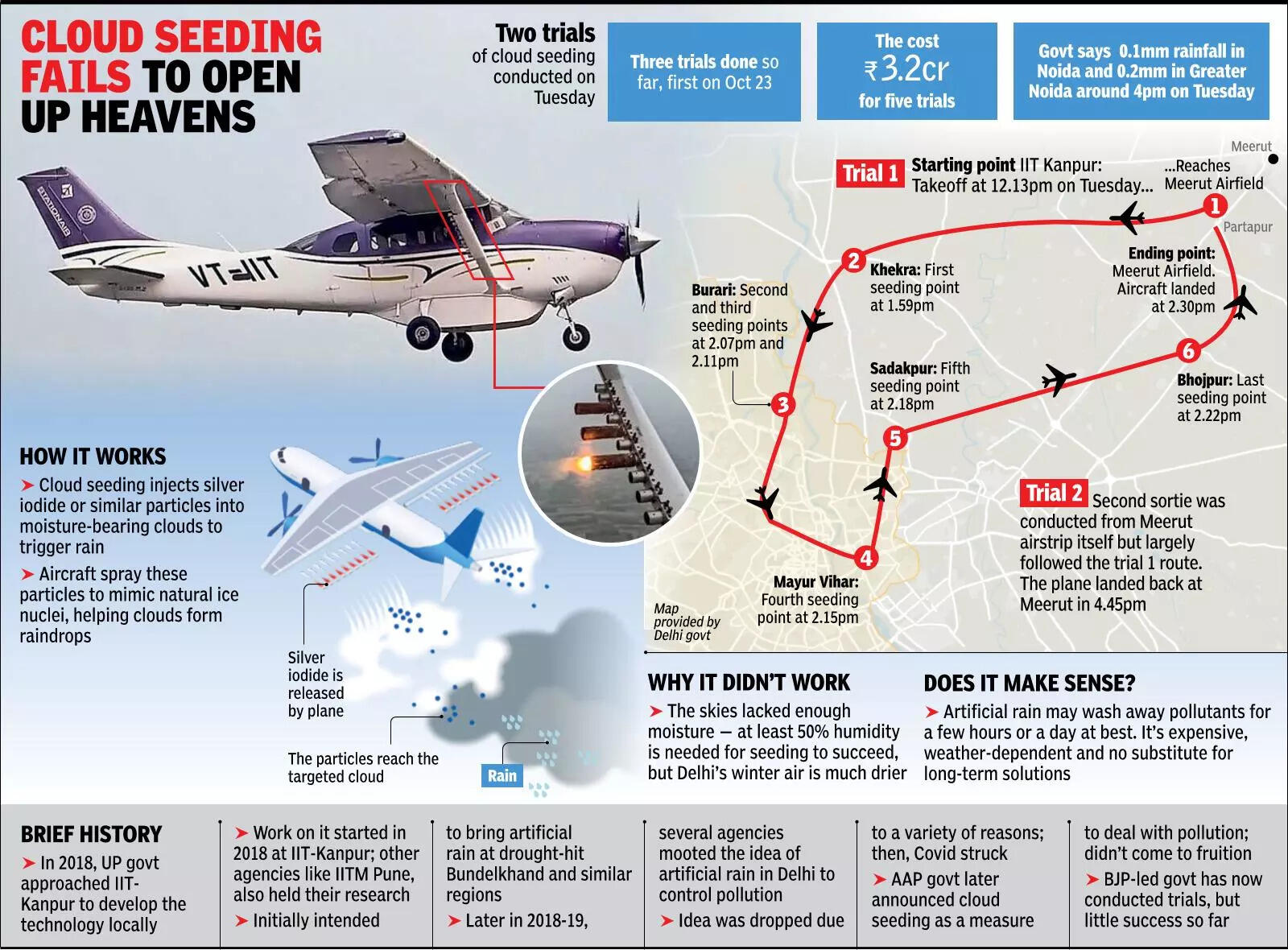NEW DELHI: The Delhi govt attempted two trials of cloud seeding on Tuesday, but neither led to any rainfall in the city. However, IIT Kanpur, which executed the project, claimed that neighbouring areas received negligible rainfall – Noida (0.1 mm) and Greater Noida (0.2 mm) at 4pm attributing the data to a private app, Windy.Delhi environment minister Manjinder Singh Sirsa said, “According to expert forecasts, rain after seeding could occur anytime in next 24 hours, depending on cloud moisture. Initial radar readings and ground observations recorded light rainfall at Delhi-Noida Border around 4pm, indicating some positive response from the seeded clouds.”
In the first trial, the Cessna aircraft of IIT Kanpur took off at 12.13pm from Kanpur and landed at Meerut at 2.30pm. The seeding points included Khekra, Burari, north Karol Bagh, Mayur Vihar, Sadakpur and Bhojpur. The second sortie started from Meerut carrying 4kg of seeding material and landed back at the same place. The main waypoints were the same as the first sortie.The second trial started at 3.45 pm, with the first seeding at Khekra at 4.08 pm, followed by Burari, Mayur Vihar, Pavi Sadakpur, Noida, Bhojpur, Modinagar and Meerut, before landing back at 4.45 pm, an IIT Kanpur statement said.

Back-To-Back Attempts At Cloud Seeding; Sirsa Calls It A Huge Step To Mitigate Pollution
3 Trials, Rs 1.9cr, 0.3mm: Wait for rain continues Each flare weighed about 0.5 kg, with eight flares released per sortie, dispersing a tested mixture designed to enhance precipitation potential. Reported humidity levels in seeded clouds ranged from 15-20% – lower than ideal, but sufficient for a scientifically meaningful test. The operation lasted about one and a half hours for each sortie, ensuring consistent coverage,” said Sirsa.Following the trials, IIT Kanpur too said the moisture content remained low at 10-15%, which is not an ideal condition for seeding. “The PM2.5 was 221, 230, and 229 reported from Mayur Vihar, Karol Bagh, and Burari, respectively, before cloud seeding, which got reduced to 207, 206, and 203 micrograms per cubic metre respectively, after the first seeding. Similarly, PM10 was 207, 206, 209 micrograms per cubic metre, which got reduced to 177, 163, 177 micrograms per cubic metre at Mayur Vihar, Karol Bagh, and Burari, respectively. Given that winds were negligible, one possible explanation is that the denser moisture content created due to seeding particles has helped in settling down a portion of these particles, which translated to these reductions,” said a report by IIT Kanpur.With this, three cloud-seeding trials have been conducted, with the first having taken place on Oct 23, which again did not lead to any rain. According to the MoU between the Delhi environment department and IIT Kanpur, the budget for cloud seeding is nearly Rs 3.21 crore for five trials. “However, IIT Kanpur said it will conduct up to nine trials from this budget. It said it is a research institute and not a profit-making institute and hence it will conduct maximum trials to help people breathe good air,” said Sirsa.The minister said this is among India’s biggest scientific steps for urban air quality control, proving Delhi’s resolve to confront legacy pollution challenges head on. “The govt’s proactive approach, thanks to the support from chief minister Rekha Gupta and guidance from Prime Minister Narendra Modi, will ensure effective and transparent climate action for the citizens,” said Sirsa.IIT Kanpur director Manindra Agrawal told TOI, “As per my knowledge, it did not rain in Delhi. The moisture content was low. However, our team has conducted different data for better understanding. Two additional attempts for cloud seeding will be conducted on Wednesday.”Experts doubted whether the cloud seeding process can lead to a reduction in air quality in absence of rain. Mukesh Khare, professor emeritus at IIT Delhi’s Civil Engineering Department said natural rain can reduce PM2.5 concentration depending on the raindrop size, their density and fall velocity. “During the rainy season, rain washes out the pollutants and suppresses them to the ground. However, clouds are generally devoid of humidity during winters in Delhi. A mixture of silver iodide and other contents was released to make some reaction so that enough water vapour can be generated into the clouds, making them unable to hold those drops. Since only negligible rain occurred, it means cloud seeding was not able to generate enough water vapour.” He added that a mere increase in humidity within the clouds may not suppress the particles. “Humidity only can make the particles heavier. However, PM2.5 particles are very small. Unless there is a force, humidity cannot settle down PM2.5 particles. Hence, reduction in PM2.5 may have occurred due to other reasons.”
